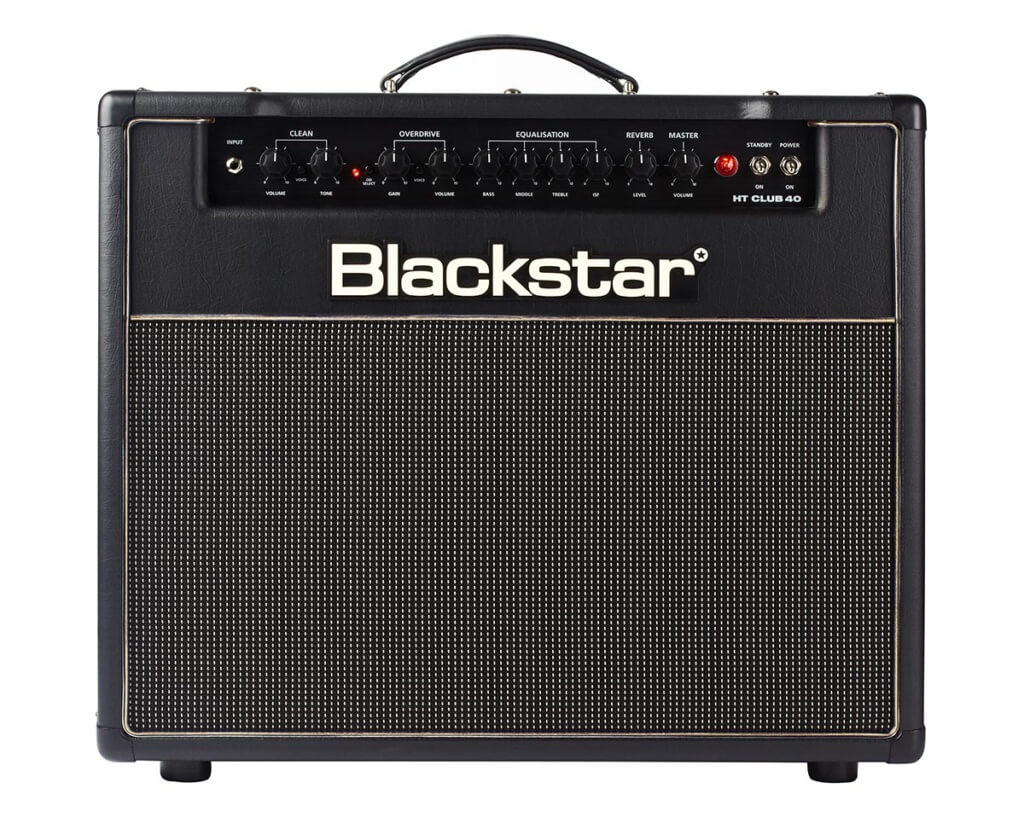The Blackstar HT Club 40 Tube Amp Delivers a Classic Mix of Clean and Crunch in a Well-Designed, Compact Unit.
Finding a decent all-tube combo amp that leans more towards modern tones that doesn’t break the bank isn’t easy. The Blackstar HT Club 40 brings plenty of modern rock and metal tones, without scorching the wallet.
While it is a 2-channel amp, the clean side is very minimal, with just a volume and a tone knob. The cleans are super sparkly; chords ring out with excellent punch. The single tone knob might seem limiting, but it’s voiced so there’s not a lot of hunting around for that perfect clean tone.

Blackstar HT Club 40
A separate voicing switch allows the clean channel to be overdriven to get that natural tube tone, or go totally modern, keeping clarity at higher volumes, with extra bass, and more high-end response.
RELATED: Check out more guitar and amp reviews from Performer.
The overdrive side has a lot more features, with Gain, Volume, and 3-Band EQ. The voicing switch works in a similar manner as the one on the clean channel, going for a slightly scooped presence, or a more classic hard rock sound: think of switching between a gold and tolex-styled amp, or a chrome diamond-plated one. The EQ can really sculpt the tone overall, throughout the range of the gain offered. This is a serious hard rock/metal machine. Yes, you can get some vintage classic rock and bluesy stuff at lower gain settings, but that’s like putting training wheels on a Harley-Davidson.
This amp really lives in the higher gain settings, places where a lot of combo amps can’t go without turning to buzzy mud. Rhythm tones are super tight, while the lead tones have loads of attack and sustain. To give even further flexibility, there is an ISP control; turn counter clockwise, and its flavor sits in the USA side of things, and clockwise, in more British sounding areas. The reverb is digital, which itself has a dark/bright switching option, and sounds as bright and snappy as a spring-driven unit. 40 watts may not seem like much, but there’s plenty of (clean) headroom to keep up with a band in a practice space or even a large club.
RELATED: Check out stompbox and fx pedal reviews and videos from Performer.
On the back panel, there is an effects loop, with the ability to select for line level (rack mounted) or instrument level (pedals). It’s a nice option to have; time-based effects like reverbs, delays and modulations sound better in an effects loop, and as the trend of more complex pedalboards becomes more common, it’s a great way to get the most out of a rig. The usual speaker outputs of 8 and 16 ohms reside next to a Speaker Emulated output for recording or even live use. Even better is it can work silently; just disconnect the speaker, turn the master volume to 0, or set the amp to standby mode.

Blackstar HT Club 40 rear panel
Behind a removable panel on the back is the business end, a 1×12 Celestion 80 speaker, as well as (2) EL34 and (2) ECC83 (12AX7) tubes that give the amp this great crushing and dynamic tone. Considering the back panel is secured by 12 screws, any issues that arise at a gig or practice may require a lot of work to diagnose, which is a slight bummer. There aren’t a lot of amps we’ve seen at this level that go into this high gain area, without a lot of help from digital modeling or some other solid state technology. The only pedal that might be needed is a boost for pushing some solos over the top of the mix (depending on the musical situation). A player who relies on a high gain pedals to get those modern rock/metal tones may want to take a look at this to help clean up their signal path.

Blackstar HT Club 40 front panel
PROS:
Flexible modern rock/metal tones GALORE, plenty of tonal EQ options on the overdrive side.
CONS:
Back panel is a pain to remove if any issues arise.
PRICE:
$599
BLACKSTAR HT CLUB 40 FEATURES
-2xECC83 preamp tubes
-2xEL34 power tubes
-2 footswitchable channels (footswitch included)
-12″ Celestion speaker
-Patent-Applied for Infinite Shape Feature (ISF)
-Digital reverb with dark/bright switch
-Speaker emulated output
-Effects loop
What do you think of Blackstar HT Club 40 review? Let us know in the comments below or drop a line on the Performer Magazine Facebook page or on Twitter @Performermag.
